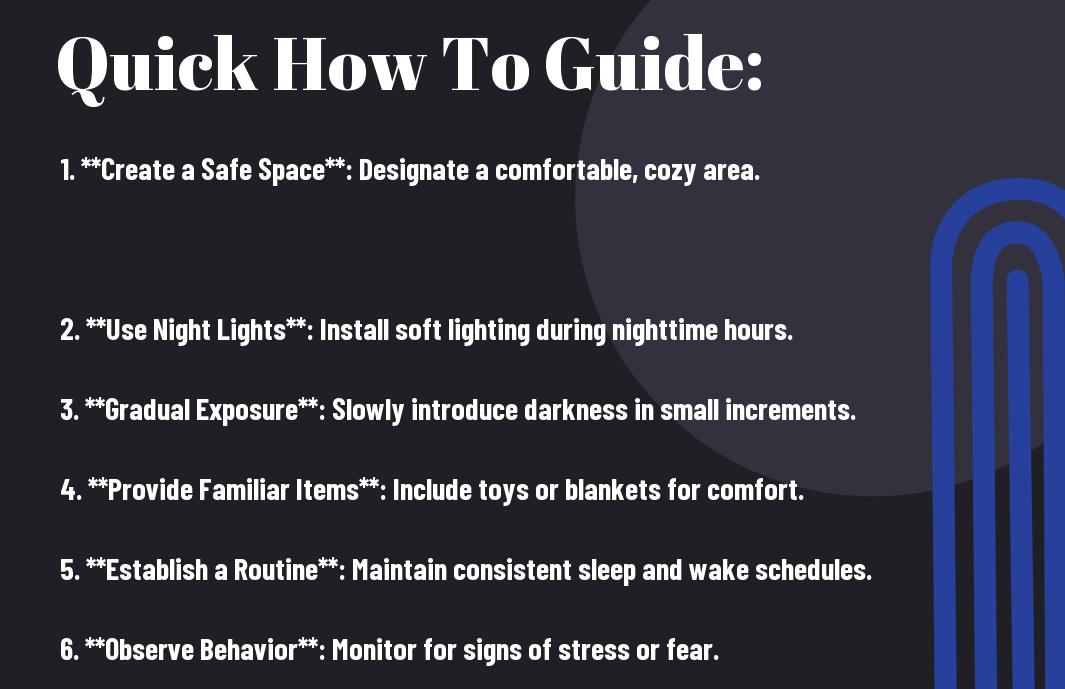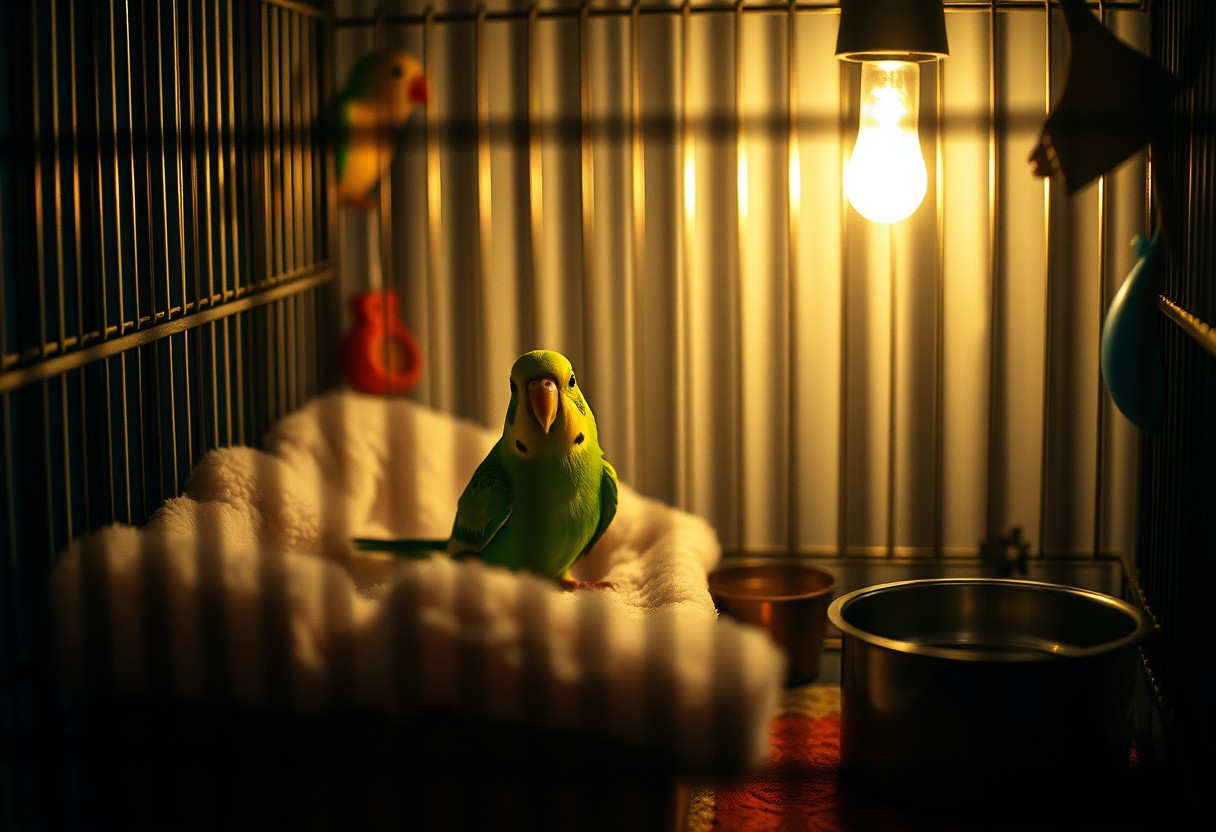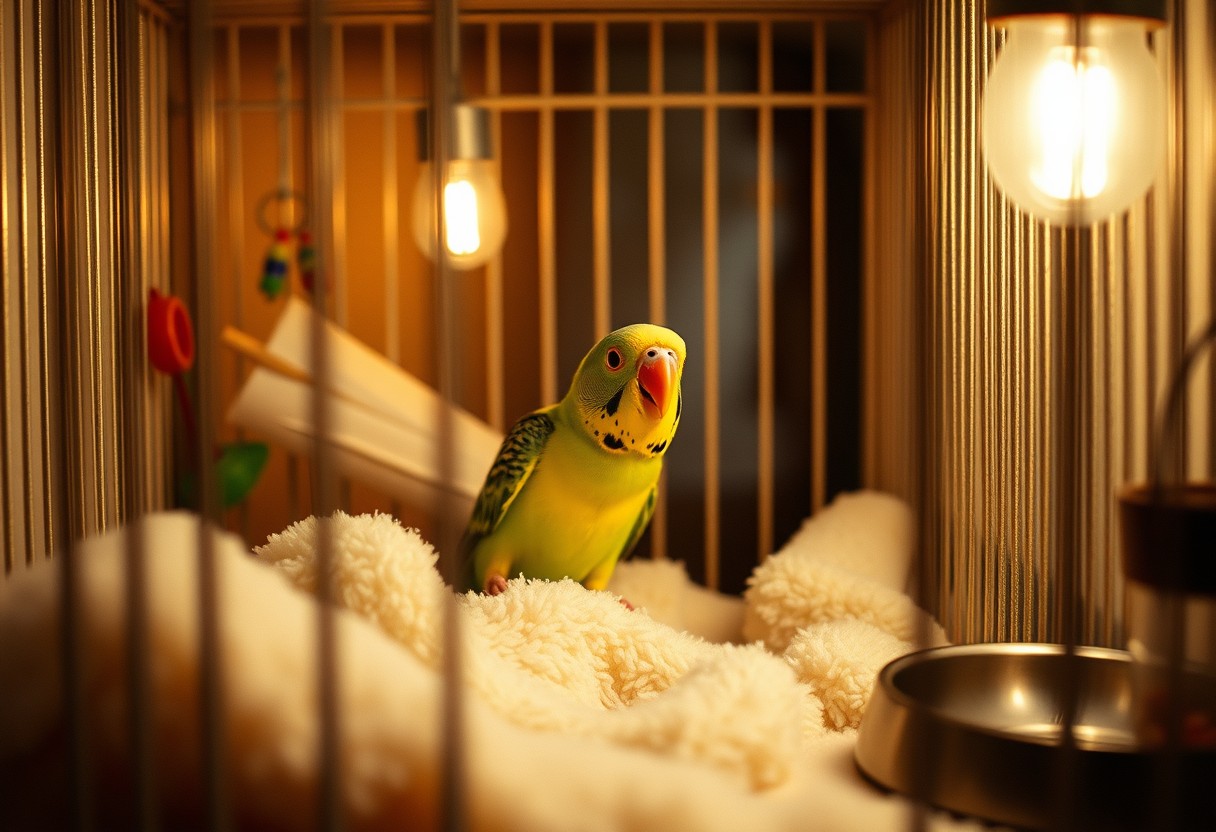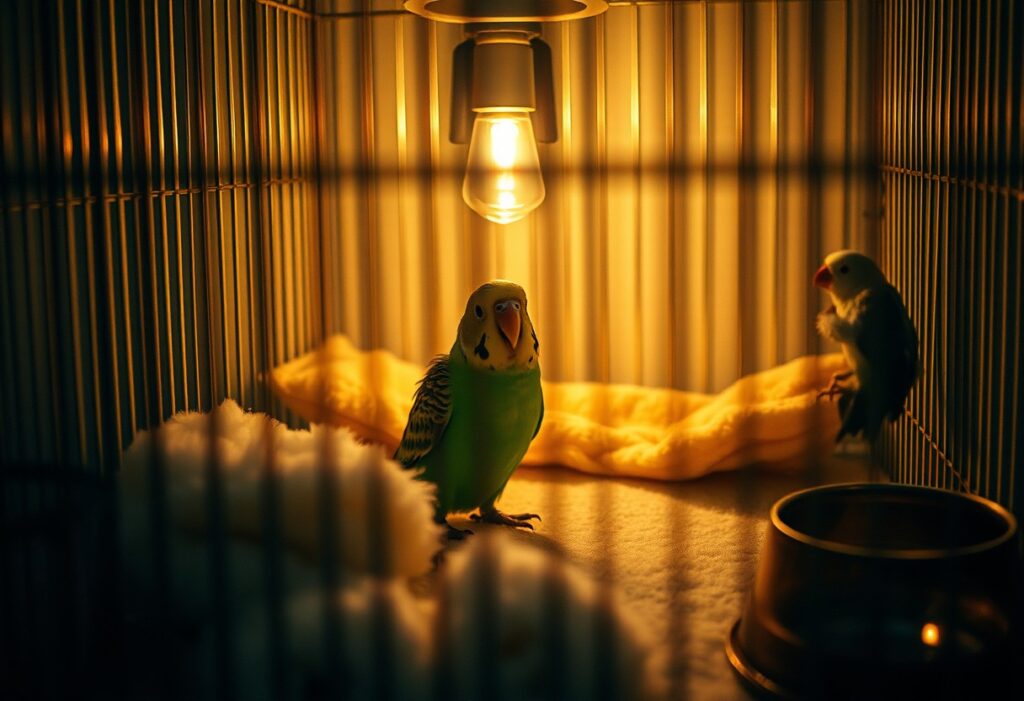There’s nothing quite like the bond you share with your feathered friend, but if your bird is afraid of the dark, it can lead to stress for both of you. Understanding your bird’s fear is crucial in helping them feel secure, especially during those nighttime hours. In this guide, you will learn effective strategies to alleviate your bird’s anxiety, create a comforting environment, and ensure that they remain healthy and happy despite their fears. Your commitment to their well-being will strengthen your relationship and ease their nighttime stress.


Understanding Fear of the Dark
A common issue many bird owners face is their pet’s fear of the dark. This fear can stem from various factors, and understanding these elements is crucial in helping your bird feel more secure. Birds, like many animals, are instinctively programmed to be cautious of their surroundings, especially in low light, which can impede their ability to perceive potential threats. While it’s normal for birds to have some degree of fear when the lights go out, excessive anxiety can affect their health and overall well-being.
Common Factors Contributing to Fear
Little is known about the specific psychology of birds, but several common factors contribute to their fear of darkness:
- Previous negative experiences in low-light conditions
- Instinctual responses to potential predators lurking unseen
- Limited exposure to low-light environments
- Inadequate socialization with humans or other pets
Perceiving the world mainly through sight and sound, your bird may react adversely to changes in lighting, causing them to be more anxious in darker situations.
Signs Your Bird is Afraid of the Dark
You might notice several behavioral changes in your bird that signals fear of the dark. These signs can manifest as vocalizations, erratic movement, or attempts to escape from their enclosure. Common behaviors include excessive squawking, flapping their wings, or becoming uncharacteristically quiet and withdrawn. Observing your bird during low-light conditions is crucial for identifying their level of fear.
The courage of your bird can be compromised by their fear of the dark. Signs such as frantic fluttering, hiding, or even aggressive behavior are critical indicators that your feathered friend might be feeling stressed. Ensuring a consistent and calming environment can help alleviate their anxiety. Providing gradual exposure to darkness using dimming lights or covering their cage with a breathable fabric can assist your bird in adjusting to low-light conditions, making them feel more secure and reducing their fear.
Creating a Safe Environment
You want to create an environment where your bird feels safe and secure, especially if it has a fear of the dark. This involves paying attention to the conditions in its habitat and ensuring that its sleeping area is both comfortable and reassuring. By doing so, you can help reduce your bird’s anxiety and promote peaceful rest, which is necessary for its overall well-being.
Optimal Lighting Conditions
On a practical level, providing optimal lighting conditions is crucial when managing a bird that’s afraid of the dark. You should ensure that your bird’s cage is positioned in a well-lit area during the day, allowing natural light to filter in. At night, however, maintaining a gentle glow is important. Bright lights or total darkness can cause unnecessary stress for your feathered friend, so aim to have a soft light that can help your bird feel secure while it rests.
Additionally, you might consider utilizing dimmable lights or LED strips that can adjust in brightness throughout the evening. This gradual change helps mimic a natural sunset, allowing your bird to settle without sudden changes that could ignite its fear of the dark.
Comfortable Sleeping Spaces
If your bird is going to feel safe, you need to provide comfortable sleeping spaces within its cage. This might include soft, cozy materials such as bird-safe blankets and perches that offer enough support and comfort. Your bird should have a designated sleeping area that feels secure and sheltered, which may be a covered nest or a small cozy corner in its cage. Make sure this space is away from any drafts or noise that could disturb its sleep.
Spaces that are too large can create a sense of vulnerability for your bird. Therefore, aim to create a nook-like atmosphere where your bird can feel more enclosed and protected while resting. The right setup promotes relaxation and can significantly ease your bird’s anxiety during the night.
Use of Night Lights
You might also consider the use of night lights in your bird’s environment. These lights can provide a low level of illumination that can help your bird feel more secure during the dark hours of the night. It is crucial to choose lights that emit a soft glow instead of harsh, bright light, as the latter can be unsettling. Placing a small night light near the cage can help your bird navigate and feel secure without the overwhelming darkness that might otherwise trigger its fear.
Conditions of light play a significant role in affecting your bird’s mood and anxiety levels. Choosing the right type of night light can make a noticeable difference. When identifying one, be mindful of how close it is to the cage and ensure it is not too hot or bright, which could cause discomfort or stress for your bird.

Behavioral Management Techniques
For birds that exhibit a fear of the dark, implementing effective behavioral management techniques is crucial for their emotional well-being. These methods can help your feathered friend feel safe and secure during the nighttime hours, thereby reducing stress and anxiety. By understanding and applying these techniques, you stand a better chance of fostering a relaxed environment for your bird.
Gradual Acclimation to Darkness
Some birds can become easily frightened by sudden darkness, leading to panic and distress. To help your bird adjust, gradually acclimating them to reduced light levels is crucial. Start by dimming the lights a little earlier than usual each evening, allowing your pet to become accustomed to the fading light. Over the course of several days or weeks, you can gradually increase the intensity of the darkness as your bird appears more comfortable. This patient approach allows your bird to adjust to the night on their own terms.
Another method to consider is using a small nightlight in your bird’s room initially. This can provide a comforting glow that alleviates fears of complete darkness while still encouraging an understanding of the transition from day to night. As your bird begins to associate the dim light with safety, you can slowly reduce the brightness until they are more at ease with the darkness itself.
Positive Reinforcement Strategies
Behavioral management can often hinge on the concept of positive reinforcement. This involves rewarding your bird for displaying calm behavior when the lights are dimmed or turned off. By offering treats, affection, or verbal praise each time your bird shows signs of comfort in darkness, you create a positive association that can help alleviate their fear. Over time, this association can be strengthened, leading to a more confident and relaxed bird.
Management of your bird’s fear of the dark can also benefit from understanding the timing of your positive reinforcement. Reward your bird immediately after they exhibit calmness in a dimly lit environment, which reinforces the desired behavior. Utilize your bird’s favorite treats or toys as incentives; this makes the process both effective and enjoyable for your pet.
Establishing a Routine
Gradual exposure to darkness can be complemented by a consistent routine. Birds thrive on predictability, and having a set evening schedule can help your pet feel more secure. Establishing a weekly routine that includes a specific time for lights to dim and activities to engage in before bedtime can reduce anxiety and make the transition to night easier for your bird.
Another important aspect of establishing a routine is ensuring that your bird’s sleep environment remains stable. You should aim to keep the lighting, sounds, and general atmosphere consistent each night. By creating a predictable and calm environment, you can significantly reduce the likelihood of nighttime anxiety for your bird, fostering a sense of safety and security.
Additional Tips for Bird Owners
Unlike many other pets, birds can be particularly sensitive to their environment, and many can develop a strong fear of the dark. Managing such fears involves a combination of understanding, care, and proactive measures. Here are a few crucial tips you might consider implementing in your bird-care routine:
- Ensure your bird’s cage is set up in a well-lit area that becomes dimly lit gradually at night.
- Provide a night light or infrared light that makes the environment seem less intimidating.
- Create a consistent bedtime routine to help your bird feel more secure.
- Incorporate comforting toys or nesting materials to establish a safe space.
- Monitor your bird’s reactions during the transition from daylight to darkness.
Recognizing that your bird’s fear may stem from unfamiliar situations, it’s crucial to address their discomfort with patience and confidence. Managing a bird that is afraid of the dark can take time and requires a solid understanding of their needs and behaviors.
Monitoring Your Bird’s Behavior
Behavior monitoring is a vital aspect of understanding your bird’s psychological state. Observe how your bird reacts during low-light conditions and take note of any signs of distress. Common behaviors like excessive squawking, pacing, or hiding can indicate that your pet is feeling anxious. By tracking these patterns, you can pinpoint specific triggers that may cause fear and anxiety, allowing you to better tailor your approach in making their environment more comfortable.
In addition to observing general behavior, pay attention to small changes in your bird’s routine. A sudden change in activity level or feeding habits can indicate that your bird is not adapting to changes in lighting conditions. Keeping a journal may help you track these changes over time and identify when your bird feels safest, allowing you to create a more supportive environment tailored to their needs.
Consulting with Avian Experts
On your journey to helping a bird that is afraid of the dark, it might be beneficial to reach out to avian experts. Experts can provide guidance tailored to your specific bird species and their unique behavior. Veterinarians specialized in avian care can help rule out underlying health issues that might be contributing to your bird’s anxiety, while also offering advice on behavioral therapy options.
Bird owners who connect with avian specialists may benefit from gaining insights into tailored solutions, which can lead to a more profound understanding of their bird’s psychology. You might also consider joining forums or local bird enthusiast groups for additional support and shared experiences.
Importance of Social Interaction
Clearly, social interaction plays a crucial role in alleviating the fears of your bird. Birds are inherently social creatures, and engaging with them regularly can promote a sense of security and well-being. By spending time with your bird each day, you create a bond of trust, reducing their anxiety levels, especially during times of darkness.
With regular interaction, you’ll help your bird feel less isolated and more comfortably integrated into your home environment. Engaging activities such as talking, playing games, or offering treats can stimulate their senses while providing comfort. You can significantly impact your pet’s emotional health and resilience by nurturing this bond.
To Wrap Up
Taking this into account, managing a bird that’s afraid of the dark requires a systematic approach that prioritizes your feathered friend’s comfort and security. Begin by gradually acclimating your bird to lower light levels during the evening hours. Utilize dimmable lights or nightlights in their environment to alleviate the sudden transition into darkness, creating a calming atmosphere for your pet. Additionally, consider placing familiar objects, such as toys or perches, within their line of sight, as this can help to instill a sense of safety and control in their surroundings.
Furthermore, it’s imperative to observe your bird’s behavior closely to better understand their specific fears and triggers. Engage with your pet in positive reinforcement training, rewarding them during the acclimatization process to build confidence. Pay attention to their body language, as this will help you gauge their comfort level. By creating a safe and nurturing environment where your bird feels secure, you can significantly reduce their fear of the dark and enhance their overall well-being. Be mindful of, patience and consistency are key in helping your bird adapt to their nighttime routine.
FAQ
Q: What are the signs that my bird is afraid of the dark?
A: Birds that are afraid of the dark may exhibit various signs of distress. Look for behaviors such as excessive squawking or chirping, flapping around their cage, or trying to hide or retreat to corners. You might also notice changes in their eating habits, such as refusing to eat or drinking less water. Additionally, a bird may become increasingly restless or agitated as the light fades. Recognizing these signs can help you determine if your bird needs extra comfort or support during the nighttime hours.
Q: How can I create a comfortable sleeping environment for my bird?
A: To create a comfortable sleeping environment, ensure that your bird’s cage is placed in a quiet, dark area that mimics its natural habitat. You can use a soft, breathable cover over the cage that provides darkness while still allowing for some airflow. Make sure the cage has appropriate perches and nesting materials where the bird can feel safe. Additionally, consider using a dim nightlight with a red or orange hue, as it is less disruptive to birds’ sleep cycles compared to white light. Over time, these adjustments can help your bird feel more secure at night.
Q: Is it necessary to adjust my bird’s light schedule, and if so, how?
A: Yes, adjusting your bird’s light schedule is important to help them feel comfortable. Birds thrive on a consistent day-night cycle, so aim to provide 10-12 hours of light followed by 12-14 hours of darkness. Gradually transition your bird to this new schedule over several days, ensuring that the light gradually dims in the evening. Use a timer to maintain consistency and help your bird adapt to the routine. This predictability can reduce anxiety about the dark and promote better sleep patterns.











